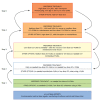2020 Brazilian Thoracic Association recommendations for the management of asthma
- PMID: 32130345
- PMCID: PMC7462684
- DOI: 10.1590/1806-3713/e20190307
2020 Brazilian Thoracic Association recommendations for the management of asthma
Abstract
The pharmacological management of asthma has changed considerably in recent decades, as it has come to be understood that it is a complex, heterogeneous disease with different phenotypes and endotypes. It is now clear that the goal of asthma treatment should be to achieve and maintain control of the disease, as well as to minimize the risks (of exacerbations, disease instability, accelerated loss of lung function, and adverse treatment effects). That requires an approach that is personalized in terms of the pharmacological treatment, patient education, written action plan, training in correct inhaler use, and review of the inhaler technique at each office visit. A panel of 22 pulmonologists was invited to perform a critical review of recent evidence of pharmacological treatment of asthma and to prepare this set of recommendations, a treatment guide tailored to use in Brazil. The topics or questions related to the most significant changes in concepts, and consequently in the management of asthma in clinical practice, were chosen by a panel of experts. To formulate these recommendations, we asked each expert to perform a critical review of a topic or to respond to a question, on the basis of evidence in the literature. In a second phase, three experts discussed and structured all texts submitted by the others. That was followed by a third phase, in which all of the experts reviewed and discussed each recommendation. These recommendations, which are intended for physicians involved in the treatment of asthma, apply to asthma patients of all ages.
O manejo farmacológico da asma mudou consideravelmente nas últimas décadas, com base no entendimento de que a asma é uma doença heterogênea e complexa, com diferentes fenótipos e endótipos. Agora está claro que o objetivo do tratamento da asma deve ser alcançar e manter o controle da doença e evitar riscos futuros (exacerbações, instabilidade da doença, perda acelerada da função pulmonar e efeitos adversos do tratamento). Isso implica em uma abordagem personalizada, incluindo tratamento farmacológico, educação do paciente, plano de ação por escrito, treinamento para uso do dispositivo inalatório e revisão da técnica inalatória a cada visita ao consultório. Um painel de 22 pneumologistas brasileiros foi convidado a revisar criticamente evidências recentes de tratamento farmacológico da asma e a preparar esta recomendação, um guia de tratamento adaptado à nossa realidade. A escolha dos tópicos ou questões relacionadas às mudanças mais significativas nos conceitos e, consequentemente, no manejo da asma na prática clínica foi realizada por um painel de especialistas. Foi solicitado a cada especialista que revisasse criticamente um tópico ou respondesse a uma pergunta, com base em evidências, para estas recomendações. Numa segunda fase, três especialistas discutiram e estruturaram todos os textos submetidos pelos demais e, na última fase, todos revisaram e discutiram cada recomendação. As presentes recomendações se aplicam a adultos e crianças com asma e destinam-se a médicos envolvidos no tratamento da doença.
Figures



References
-
- Global Initiative for Asthma [homepage on the Internet] Global Strategy for Asthma Management and Prevention (2019 update) Bethesda: Global Initiative for Asthma; 2019. https://ginasthma.org/wp-content/uploads/2019/06/GINA-2019-main-report-J...
-
- Beasley R, Hancox RJ, Harwood M, Perrin K, Poot B, Pilcher J. Asthma and Respiratory Foundation NZ adult asthma guidelines a quick reference guide. N Z Med J. 2016;129(1445):83–102. - PubMed
-
- Healthcare Improvement Scotland [homepage on the Internet] Edinburgh: Scottish Intercollegiate Guidelines Network; https://www.sign.ac.uk/sign-158-british-guideline-on-the-management-of-a...
-
- National Asthma Council Australia [homepage on the Internet] Sidney: National Asthma Council Australia; 2019. https://www.asthmahandbook.org.au/
-
- National Institute for Health and Care Excellence [homepage on the Internet] Asthma: diagnosis, monitoring and chronic asthma management. London: the Institute; 2017. https://www.nice.org.uk/guidance/ng80/resources/asthma-diagnosismonitori... - PubMed

